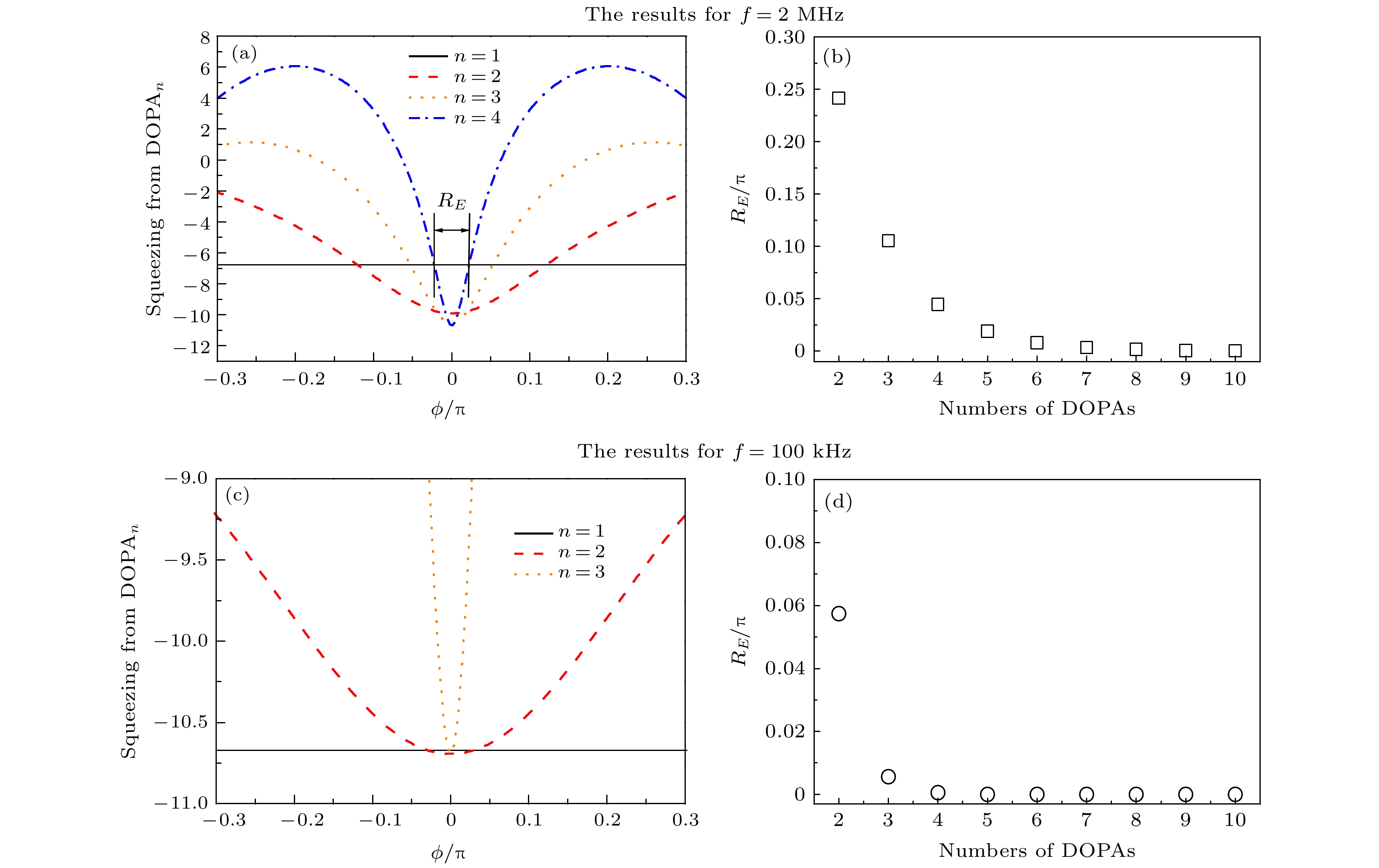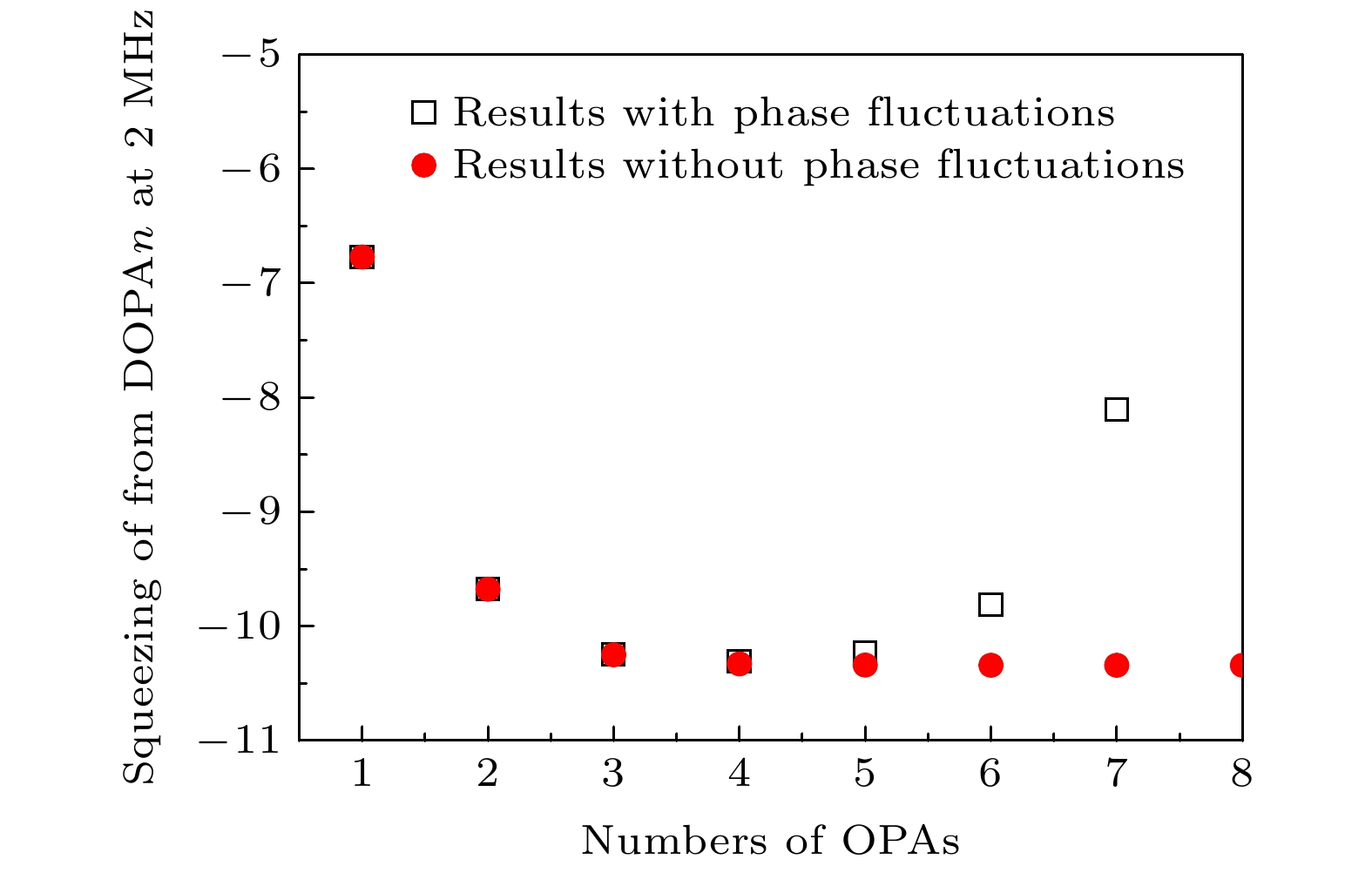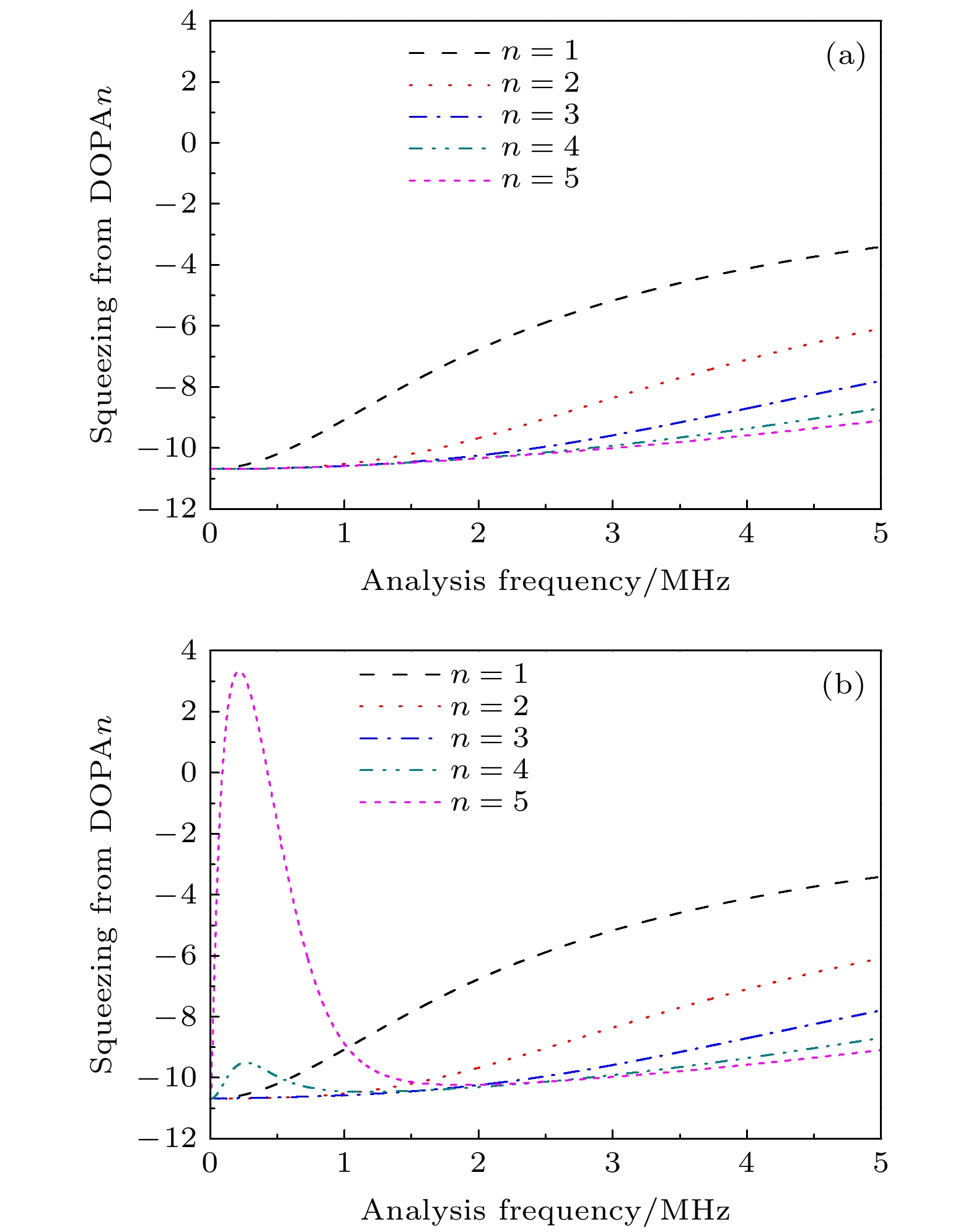-
碱金属原子跃迁线波段压缩态光场是量子信息以及精密测量领域的重要量子资源. 碱金属原子跃迁线波长短(760—860 nm), 受限于非线性晶体的灰迹效应, 光参量放大器制备的此波段压缩态光场的压缩度有限, 目前典型值约3—5 dB. 本文在光参量放大器的理论模型基础上, 结合原子跃迁线波段压缩态光场实验制备面临的问题, 研究光参量放大器输出光场量子噪声随其物理参数的变化规律, 获得最优的物理参数. 构建了级联光参量放大器的理论模型, 以此为基础分别在分析频率2 MHz和100 kHz, 研究了级联环路光学损耗以及相位噪声对级联系统输出量子噪声特性的影响. 研究发现, 对于兆赫兹波段的压缩, 在低的光路损耗以及位相噪声前提下, 级联2—3个光参量放大器可实现压缩的显著提升; 对于低频段压缩, 级联系统对压缩的增强较小. 在目前的实验参数条件下, 进一步探究了级联系统输出压缩态光场的量子极限以及频谱特性. 本研究可为原子跃迁线波段压缩态光场压缩度的提升提供参考和指导.The squeezed light field in the band of alkali metal atomic transitions is an important quantum resource in the field of quantum information and precision measurement. The wavelengths of atomic transition lines (760–860 nm) are relatively short. Limited by the gray-tracking effect of nonlinear crystals, the squeezing degree of the squeezed light in this band generated by the optical parametric amplifiers is low. Now, the squeezing is about 3–5 dB. Considering the problems in the experimental generation of the squeezed light at the wavelengths of atomic transitions, the variation law of quantum noise of the light field output from the single optical parametric amplifier with its physical parameters is studied theoretically, and the optimal physical parameters are obtained. To further improve the squeezing in the band of alkali metal atomic transitions, the cascaded optical parametric amplifiers are considered. Based on the basic theory of the optical parametric amplifiers, the theoretical model of the cascaded optical parametric amplifiers is constructed, in which the optical loss and phase noise of the cascaded optical loops are considered. Based on this, the quantum noise characteristics of the light field output from the cascaded system versus the optical loss and phase noise are analyzed at the frequencies of 2 MHz and 100 kHz, respectively. It is found that for the squeezing at 2 MHz, cascading 2 to 3 optical parametric amplifiers can significantly improve the squeezing under the premise of the low optical path loss and phase noise; for the squeezing in the low-frequency band, the enhancement of the squeezing for the cascaded system is quite weak. Under the current experimental parameters, the squeezing at 2 MHz of the squeezed light on rubidium resonance can be improved from –5 dB to –7 dB by cascading another DOPA. For the squeezing at low frequency band, the cascaded system proves to be useless, and the efforts should be made to reduce the technique noise in the low frequency band. Furthermore, the quantum limit and spectral characteristics of the squeezed light field output from the cascaded system are further explored. This study can provide reference and guidance for the improvement in the squeezing degree of the band of atomic transitions.
-
Keywords:
- optical parametric amplifiers /
- the squeezed light field /
- the cascaded system /
- squeezing enhancement
[1] Li B B, Bilek J, Hoff U B, Madsen L S, Forstner S, Prakash V, Schäfermeier C, Gehring T, Bowen W P, Andersen U L 2018 Optica 5 850
 Google Scholar
Google Scholar
[2] Lawrie B J, Lett P D, Marino A M, Pooser R C 2019 ACS Photonics 6 1307
 Google Scholar
Google Scholar
[3] Su X L, Hao S H, Deng X W, Ma L Y, Wang M H, Jia X J, Xie C D, Peng K C 2013 Nat. Commun. 4 2828
 Google Scholar
Google Scholar
[4] Usenko V C 2018 Phys. Rev. A 98 032321
 Google Scholar
Google Scholar
[5] Yan Z H, Wu L, Jia X J, Liu Y H, Deng R J, Li S J, Wang H, Xie C D, Peng K C 2017 Nat. Commun. 8 718
 Google Scholar
Google Scholar
[6] Wolfgramm F, Cerè A, Beduini F A, Predojević A, Koschorreck M, Mitchell M W 2010 Phys. Rev. Lett. 105 053601
 Google Scholar
Google Scholar
[7] Bai L L, Wen X, Yang Y L, Zhang L L, He J, Wang Y H, Wang J M 2021 J. Opt. 23 085202
 Google Scholar
Google Scholar
[8] Wu L A, Kimble H J, Hall J L, Wu H F 1986 Phys. Rev. Lett. 57 2520
 Google Scholar
Google Scholar
[9] Vahlbruch H, Mehmet M, Danzmann K, R Schnabel 2016 Phys. Rev. Lett. 117 110801
 Google Scholar
Google Scholar
[10] Sun X C, Wang Y J, Tian L, Zheng Y H, Peng K C 2019 Chin. Opt. Lett. 17 072701
 Google Scholar
Google Scholar
[11] Suzukia S, Yonezawa H, Kannari F, Sasaki M, Furusawa A 2006 Appl. Phys. Lett. 89 061116
 Google Scholar
Google Scholar
[12] Takeno Y, Yukawa M, Yonezawa H, Furusawa A 2007 Opt. Express 15 4321
 Google Scholar
Google Scholar
[13] 左冠华, 杨晨, 赵俊祥, 田壮壮, 朱诗尧, 张玉驰, 张天才 2020 物理学报 69 014207
 Google Scholar
Google Scholar
Zuo G H, Yang C, Zhao J X, Tian Z Z, Zhu S Y, Zhang Y C, Zhang T C 2020 Acta Phys. Sin. 69 014207
 Google Scholar
Google Scholar
[14] Tanimura T, Akamatsu D, Yokoi Y, Furusawa A, Kozuma M 2006 Opt. Lett. 31 2344
 Google Scholar
Google Scholar
[15] Hétet G, Glöckl O, Pilypas K A, Harb C C, Buchler B C, Bachor H A, Lam P K 2007 J. Phys. B 40 221
 Google Scholar
Google Scholar
[16] Han Y S, Wen X, He J, Yang B D, Wang Y H, Wang J M 2016 Opt. Express 24 2350
 Google Scholar
Google Scholar
[17] 温馨, 韩亚帅, 刘金玉, 白乐乐, 何军, 王军民 2018 物理学报 67 024207
 Google Scholar
Google Scholar
Wen X, Han Y S, Liu J Y, Bai L L, He J, Wang J M 2018 Acta Phys. Sin. 67 024207
 Google Scholar
Google Scholar
[18] Yang W H, Wang Y J, Zheng Y. H, Lu H D 2015 Opt. Express 23 19624
 Google Scholar
Google Scholar
[19] Wang Y J, Yang W H, Li Z X, Zheng Y H 2017 Sci. Rep. 7 41405
 Google Scholar
Google Scholar
[20] Wang S, Pasiskevicius V, Laurell F 2004 J. Appl. Phys. 96 2023
 Google Scholar
Google Scholar
[21] Boulanger B, Rousseau I, Fève J P, Maglione M, Ménaert B, Marnier G 1999 IEEE J. Quantum. Electron. 35 281
 Google Scholar
Google Scholar
[22] Zhang J, Ye C G, Gao F, Xiao M 2008 Phys. Rev. Lett. 101 233602
 Google Scholar
Google Scholar
[23] Wang D, Zhang Y, Xiao M 2013 Phys. Rev. A 87 023834
 Google Scholar
Google Scholar
[24] Ye C, Zhang J 2006 Phys. Rev. A 73 023818
 Google Scholar
Google Scholar
[25] Shi S P, Wang Y J, Yang W H, Zheng Y H, Peng K C 2018 Opt. Lett. 43 5411
 Google Scholar
Google Scholar
[26] He W P, Li F L 2007 Phys. Rev. A 76 012328
 Google Scholar
Google Scholar
-
图 6 (a)和(c)为级联DOPA系统输出光场压缩度随传输光路位相延迟
$\phi $ 的变化; (b)和(d)为级联DOPA可实现压缩增强的相位区间RE随级联DOPA个数的变化 (a)和(b)为分析频率f = 2 MHz的结果; (c)和(d)为分析频率f = 100 kHz结果Fig. 6. (a) and (c) are the results for squeezing degree of the output field versus the phase delay
$\phi $ of optical loop for the cascaded DOPA; (b) and (d) are the results for the phase region RE versus numbers of DOPA; (a) and (b) are the results for f = 2 MHz; (b) and (d) are the results for f = 100 kHz.图 8 级联DOPA输出光场的压缩特性随分析频率的变化 (a)忽略传输光路位相噪声结果; (b)考虑4.42 mrad位相噪声的结果
Fig. 8. Squeezing characteristics of the output light for the cascaded DOPA versus analysis frequency: (a) The result when the phase noise induced by optical loop is ignored; (b) the result when the phase noise of 4.42 mrad is considered.
-
[1] Li B B, Bilek J, Hoff U B, Madsen L S, Forstner S, Prakash V, Schäfermeier C, Gehring T, Bowen W P, Andersen U L 2018 Optica 5 850
 Google Scholar
Google Scholar
[2] Lawrie B J, Lett P D, Marino A M, Pooser R C 2019 ACS Photonics 6 1307
 Google Scholar
Google Scholar
[3] Su X L, Hao S H, Deng X W, Ma L Y, Wang M H, Jia X J, Xie C D, Peng K C 2013 Nat. Commun. 4 2828
 Google Scholar
Google Scholar
[4] Usenko V C 2018 Phys. Rev. A 98 032321
 Google Scholar
Google Scholar
[5] Yan Z H, Wu L, Jia X J, Liu Y H, Deng R J, Li S J, Wang H, Xie C D, Peng K C 2017 Nat. Commun. 8 718
 Google Scholar
Google Scholar
[6] Wolfgramm F, Cerè A, Beduini F A, Predojević A, Koschorreck M, Mitchell M W 2010 Phys. Rev. Lett. 105 053601
 Google Scholar
Google Scholar
[7] Bai L L, Wen X, Yang Y L, Zhang L L, He J, Wang Y H, Wang J M 2021 J. Opt. 23 085202
 Google Scholar
Google Scholar
[8] Wu L A, Kimble H J, Hall J L, Wu H F 1986 Phys. Rev. Lett. 57 2520
 Google Scholar
Google Scholar
[9] Vahlbruch H, Mehmet M, Danzmann K, R Schnabel 2016 Phys. Rev. Lett. 117 110801
 Google Scholar
Google Scholar
[10] Sun X C, Wang Y J, Tian L, Zheng Y H, Peng K C 2019 Chin. Opt. Lett. 17 072701
 Google Scholar
Google Scholar
[11] Suzukia S, Yonezawa H, Kannari F, Sasaki M, Furusawa A 2006 Appl. Phys. Lett. 89 061116
 Google Scholar
Google Scholar
[12] Takeno Y, Yukawa M, Yonezawa H, Furusawa A 2007 Opt. Express 15 4321
 Google Scholar
Google Scholar
[13] 左冠华, 杨晨, 赵俊祥, 田壮壮, 朱诗尧, 张玉驰, 张天才 2020 物理学报 69 014207
 Google Scholar
Google Scholar
Zuo G H, Yang C, Zhao J X, Tian Z Z, Zhu S Y, Zhang Y C, Zhang T C 2020 Acta Phys. Sin. 69 014207
 Google Scholar
Google Scholar
[14] Tanimura T, Akamatsu D, Yokoi Y, Furusawa A, Kozuma M 2006 Opt. Lett. 31 2344
 Google Scholar
Google Scholar
[15] Hétet G, Glöckl O, Pilypas K A, Harb C C, Buchler B C, Bachor H A, Lam P K 2007 J. Phys. B 40 221
 Google Scholar
Google Scholar
[16] Han Y S, Wen X, He J, Yang B D, Wang Y H, Wang J M 2016 Opt. Express 24 2350
 Google Scholar
Google Scholar
[17] 温馨, 韩亚帅, 刘金玉, 白乐乐, 何军, 王军民 2018 物理学报 67 024207
 Google Scholar
Google Scholar
Wen X, Han Y S, Liu J Y, Bai L L, He J, Wang J M 2018 Acta Phys. Sin. 67 024207
 Google Scholar
Google Scholar
[18] Yang W H, Wang Y J, Zheng Y. H, Lu H D 2015 Opt. Express 23 19624
 Google Scholar
Google Scholar
[19] Wang Y J, Yang W H, Li Z X, Zheng Y H 2017 Sci. Rep. 7 41405
 Google Scholar
Google Scholar
[20] Wang S, Pasiskevicius V, Laurell F 2004 J. Appl. Phys. 96 2023
 Google Scholar
Google Scholar
[21] Boulanger B, Rousseau I, Fève J P, Maglione M, Ménaert B, Marnier G 1999 IEEE J. Quantum. Electron. 35 281
 Google Scholar
Google Scholar
[22] Zhang J, Ye C G, Gao F, Xiao M 2008 Phys. Rev. Lett. 101 233602
 Google Scholar
Google Scholar
[23] Wang D, Zhang Y, Xiao M 2013 Phys. Rev. A 87 023834
 Google Scholar
Google Scholar
[24] Ye C, Zhang J 2006 Phys. Rev. A 73 023818
 Google Scholar
Google Scholar
[25] Shi S P, Wang Y J, Yang W H, Zheng Y H, Peng K C 2018 Opt. Lett. 43 5411
 Google Scholar
Google Scholar
[26] He W P, Li F L 2007 Phys. Rev. A 76 012328
 Google Scholar
Google Scholar
计量
- 文章访问数: 4679
- PDF下载量: 61
- 被引次数: 0














 下载:
下载:









